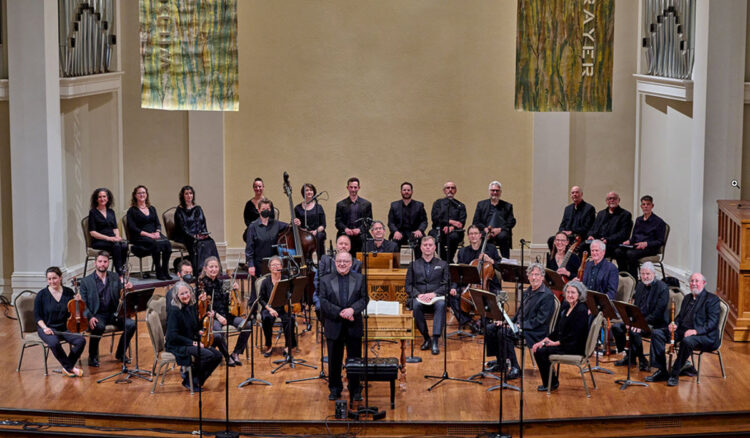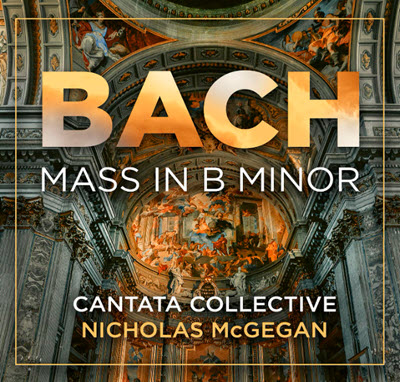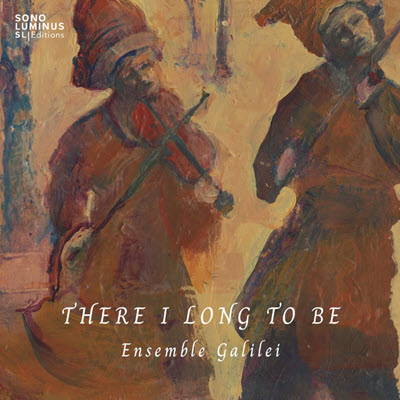by Jeffrey Baxter
Published April 21, 2024
J.S. Bach: Mass in B-minor Cantata Collective, with soprano Sherezade Panthaki, mezzo-soprano Rhianna Cockrell, tenor Thomas Cooley, and bass-baritone Paul Max Tipton, conducted by Nicholas McGegan. AVIE Records AV2668

The Mass in B-Minor took more than two decades to compose. It began life as a Lutheran Missa brevis and ultimately grew into what would be Bach’s greatest (and final) large-scale work. He not only sums up the entire musical Baroque — it’s a veritable musical lexicon of styles and statements — but all his life’s work as well.

It is this summa opus of Bach’s that the Cantata Collective, led by Nicholas McGegan, have chosen for their fourth installment of an outstanding recording initiative begun in 2020.
For this live recording, recorded in March 2023 at Berkeley’s First Congregational Church, McGegan assembled an orchestra of ten strings [3-3-2-1-1], with solo winds, brass, timpani, and organ. They are supplemented by a chorus of twenty singers [6-6-4-4] and a quartet of vocal soloists, all singing in a stylistically appropriate Germanized Latin pronunciation.
Some of the most impressive choral singing in this recording is heard in the central three choruses of the Symbolum Nicenum, the crowning glory and some of Bach’s best music in the entire Mass. The Cantata Collective’s choral forces shine in their expressive use of color and dynamic shading in the long arching lines of “Et incarnatus est” and “Crucifixus” and are able to hold their own in “Et resurrexit” — due, in part, to McGegan’s careful balancing and phrasing. This setting’s dance-like style, with its clear-cut phrase structure and triple meter resembling a courante, point to a secular origin — a form of worldly rejoicing which Bach considered appropriate to the euphoria of the Resurrection.
Likewise, for the closing pair of “Confiteor” and “Et expecto,” McGegan’s choral forces muster their best efforts. The lean motet-style and accompaniment of only basso continuo helps them shine in “Confiteor.” One only wishes there were a starker contrast — in color and dynamic shading — for the sublime 26-measure Adagio “expectation” before the final Vivace. The movement builds to a crashing, energetic close, on “Amen,” here served well with little or no rallentando.
Bach’s solution for a Sanctus movement was easy: he had already written several Sanctus settings for liturgical use in Leipzig, and from these he chose one of his most brilliantly orchestrated and symbol-laden settings (from 1724). The Holy Trinity is represented by the pervasive presence of three: three trumpets, three oboes, a six-voice chorus (three high voices versus three low voices, representing perhaps the six-winged Seraph in Isaiah) — all proclaiming the text in a repeated triplet pattern — sometimes in 3rds and its inversion, 6ths — often in three-bar phrases.
Miraculously, the small choral forces of the Cantata Collective beautifully dispatch both this and the following double-choir Osanna with no issues at all, aside from a slightly awkward transition from the triplets of “Sanctus” to the running 8th notes of “Pleni sunt coeli.” Either the “Sanctus” should start slower or a more deliberate ritardando allowed for the transition to set-up the eighth-note triplets as constant in the new 3/8 tempo.
Along the way there are a few rough spots. The Mass’ opening cries of “Kyrie,” in whose gripping first four measures Bach lays bare the soul, sound weak in this recording’s plaintive and subdued opening (with an added diminuendo in m. 4). This underwhelming beginning, combined with a lack of rhythmic profile in individual choral lines in the ensuing five-voice fugue, makes for a lackluster start that undermines the music’s profound connection to the text, with its rising and falling arcs of aspiration and supplication.
The sung text is obscured by an under-articulated dotted figure on the first four syllables of the fugue’s main subject, on “Ky-ri-e e-[le-i-son].” This comes across like a static half-note, rather than the urgency Bach builds into the dotted 8th and 16th notes. In perhaps an effort of creating an effect of subdued piety, the choral lack of attention to the rhythmic integrity of the phrase almost renders the first word of the sung text (“Kyrie”) unintelligible and deprives the movement of its expressive urgency.
In contrast, the ensuing soprano-alto duet, “Christe eleison” — expertly sung by soprano Sherezade Panthaki and mezzo Rhianna Cockrell — is full of character, providing the intended depiction of the more human side of the Trinity. The voices sing in perfect harmony (dulcet 3rds and 6ths) as well as in overlapping imitative counterpoint, suggesting that Father and Son are one.
Vocally, Bach undoubtedly had in mind the fine court singers in Dresden who excelled in operatic repertoire. For this setting he crafted a “modern” vocal duet — not operatic but, rather, like one from his Lutheran cantatas — in contrast to the austere “Kyrie” that proceeded it and to the one that will follow.
The stile antico second “Kyrie” (in F-sharp minor), with its canonic imitation of a musical subject that literally “crosses” itself, is clear in execution, despite some sagging intonation in the opening statements. Curiously, the performers are never allowed to bloom in this reading, leading to a disappointing final page of music where the soaring voices build to their highest notes sung so far in this movement. The effect is pale, but at least the tempo never sags under McGegan. Still, the listener is left wanting a true sense of arrival in this movement so carefully proportioned by Bach.
While the “Gloria in excelsis Deo” opens with a blaze of expert high-flying trumpet playing, the following “Et in terra pax” grand permutation-fugue loses steam along the way, with a tempo that constantly wants to slow down in the repeated duplets of 8th notes. (Curiously, the balance between chorus and orchestra does not translate well in this recording, perhaps due to mic placement or decisions made in post-production — despite the fact that the ensembles are balanced numerically.)
The vocal and instrumental soloists are consistently strong. The voice in “Laudamus te” — marked by Bach as Soprano II — is handily dispatched by Panthaki, who can deliver in her lower register as deftly as in her effortless, agile high singing. The obbligato solo violin playing of Kati Kyme beautifully highlights Bach’s ingenious structure of a set of compressed bourrée dance gestures (in m. 3) and cleverly dovetailed ritornello figures that sometimes sneak in as false entries (as in m. 15).
Bach’s exact instrumental doubling of the voices in the ricercar-style “Gratias agimus tibi” definitely helps the chorus shine in this movement (even when the top two trumpets have their solo-moment. It is a good thing, especially since this is the music with which Bach chooses to end his missa tota.
In the Gloria’s central movement, “Domine Deus,” the Trinity is represented by three soloists. The flute is the Holy Spirit, fluttering above a pizzicato bass; the tenor portrays the Father (singing the text, “Domine Deus” at m. 17 then switches text with soprano at m. 25); and the soprano portrays the Son (singing the text, “Domine Fili” at m. 17 then switches text with tenor at m. 25).
The delicate flute solo playing in this performance subtly handles the notes inégales stylistically suggested by the notation (and in the Dresden parts that survived), but the true glory of this movement — and perhaps of the entire solo vocal quartet on this recording — comes from the singing of tenor Thomas Cooley. (He was also a standout as the Evangelist in the Cantata Collective’s excellent Johannes-Passion recording.) He brings to this Mass the Passion’s sense of drama and connection to the text, but with all the skill and sophistication of vocal refinement that anyone could ask for in this lyric role.
In the four-part chorus “Qui tollis peccata mundi,” Bach crafts a Renaissance-style motet pitted again a canon between two flutes who hover, halo-like, above the voices. The aching long suspensions in the voice parts here are lovingly drawn out by the chorus, though one suspects that, in live performance, the presence of the flute duet would not be as audible as it is in this engineered recording (especially the hollow, low register of an 18th-century traverso flute). A more restrained pianissimo approach in the choral singing might have been preferred, but the often-unheard flute detail is most welcome.
The alto aria, “Qui sedes,” harkens stylistically to the Polonaise in Bach’s Orchestral Suite No. 2 in B-Minor, BWV 1067. The aria’s opening melody, with its descending gestures, played first by the plaintive oboe d’amore, then sung by the alto, suggests genuflection. A slightly less vocal athleticism from mezzo Cockrell, especially in the approach to the higher notes sung, would better serve the Affect of this piece. Nonetheless, the good intonation and delivery of legato line is noteworthy.
In “Quoniam tu solus sanctus” bass-baritone Paul Max Tipton and horn soloist Todd Williams deliver a regal tone where Bach depicts “the most High” by the deepest forces possible: bass voice, bassoons, continuo (cello and bass), and horn.
In the Gloria’s grand choral finale, “Cum Sancto Spiritu,” Bach generates a choreatic, Pentecostal fervor, especially in its stretto entrances at ms. 85-111. But here the choral forces lose steam and lag slightly in tempo at each fugal entry. An attempt to recover energy at their homophonic statement of “in gloria Dei Patris” at ms. 112-113 proves too late to salvage the lost drive and impetus of the final measures. Perhaps an application of concerto grosso performance techniques (the soli/tutti use of vocal concertists and ripienists) in the larger choral fugues would have lent clarity and afforded more forward motion?
For the Symbolum Nicenum (the Credo), Bach contrasts deliberately archaic musical styles with modern ones, such as the pairing of the “Credo” and “Confiteor” movements (old-style compositions, grounded by a plainchant cantus firmus) with the “Patrem” and “Et expecto” movements (“modern” Baroque, festal pieces). McGegan cleverly highlights this difference by using five solo voices, along with two solo violins, to intone the “Creed” and tutti chorus at “Patrem omnipotentem.”
Since most of the final movements of the B-minor Mass are brilliant re-workings by Bach of his own earlier compositions, many researchers have assumed that the “Benedictus” must also be a parody from a now-lost model. Bach scholar (and handwriting specialist) Yoshitake Kobayashi, however, believes that the manuscript’s notes penned in light ink and then written over in dark ink indicate a newly composed piece — first sketched into the score with brown ink, then later darkened with black ink.
The movement’s melancholy tone (in B minor) certainly recalls Bach’s 1739 (B minor) Orchestral Suite No. 2 for flute and strings. Indeed, while in the “Benedictus” the solo obbligato instrument is not specified, it contains exactly the range of a transverse flute (nothing lower than a D) and recalls the character of the Orchestral Suite’s Polonaise, especially in that movement’s B-section for flute and basso continuo only.
It is the bird-like sound of the flute that suggests the Biblical account of Jesus’ baptism by John, where the Holy Spirit in the form of a dove descends from Heaven. Bach evokes an introspective hollowness in the sparse three-voice texture for flute, tenor and basso continuo. The hooty “Moanin’ Dove” timbre of the wooden transverse flute also contributes to a sense of hollowness of heart, waiting to be filled. And filled it is, by the heart-breaking elegant singing of tenor Cooley who incidentally not only exhibits the best vocal connection to the text (without expense of the legato line), but also the best German-Latin pronunciation.
The Agnus Dei represents one of the most thorough revisions Bach made for his Mass setting. He simplified the florid vocal line of BWV 11, intensified the violin-line with a wider range, shored up the phrase-structure, truncated the ABA form with a dramatic interrupting fermata (at m. 34) and shaved two minutes off the original. While the model would have been the envy of any Baroque composer, Bach was always able to see greater and greater expressive potential and “improve” on his own (and others’) works. What he “borrowed” he “re-paid” ten-fold.
Mezzo Cockrell’s beautifully controlled singing is masterful in this movement, especially at the return of the A section (m. 31), where she employs a breath-taking pianissimo. It is otherworldly and reminds me of conductor Robert Shaw’s description that a well-sung performance of this aria can make “that grandest of all ‘Dona nobis pacem’ finales sound like an encore of questionable taste.”
Luckily, the “Dona nobis pacem” is as ideally performed as the preceding aria, benefiting from an understated beginning that is carefully paced by McGegan to a triumphant end. This reading beautifully highlights Bach’s transformation of the earlier “Gratias” movement to something that represents not a petition for peace, but an arrival at a peace already attained.
As the Cantata Collective continues its journey, some other biggies are in the works: the Matthew-Passion, Magnificat, and the Easter Oratorio. I look forward to more.
Jeffrey Baxter is a retired choral administrator of the Atlanta Symphony Orchestra, where he managed and sang in its all-volunteer chorus and was an assistant to Robert Shaw. He holds a doctorate in choral music from The College-Conservatory of Music of the University of Cincinnati and has written for BACH – The Journal of the Riemenschneider Bach Institute, The Choral Journal, and ArtsATL. For Early Music America, he recently reviewed Arys Lyra Houston in an Alessandro Scarlatti oratorio.




